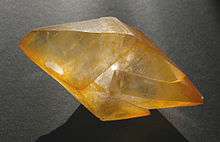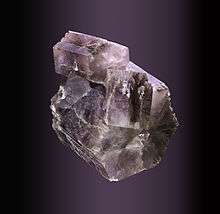Dimorphism (geology)

Doubly terminated calcite crystal.

Aragonite from Spain.
Dimorphism is the property of some minerals to exist in two different crystal systems, while still having the same chemical formula. An example: CaCO3, which exists as trigonal calcite or orthorhombic aragonite. A mineral's dimorph is the mineral that it is dimorphic with.[1][2] Dimorphism is not to be confused with allotropy, which refers to a difference in crystal structure of pure elements.
Trimorphism & Polymorphism
Trimorphism is the term used when a mineral has a total of three dimorphs,[3] while the term Polymorphism is used when there four or more. Silica, SiO2, is a good example, being found in nature as quartz, tridymite, cristobalite, coesite, and stishovite.[4] Pleomorphism is a synonym of polymorphism.[4]
See also
References
- ↑ "Definition of dimorphism - mindat.org glossary". www.mindat.org. Retrieved 2016-10-23.
- ↑ "Dimorphous - Minerals.net Glossary of Terms". www.minerals.net. Retrieved 2016-10-23.
- ↑ "Definition of trimorphism - mindat.org glossary". www.mindat.org. Retrieved 2016-10-23.
- 1 2 "Definition of polymorphism - mindat.org glossary". www.mindat.org. Retrieved 2016-10-23.
This article is issued from Wikipedia - version of the 11/19/2016. The text is available under the Creative Commons Attribution/Share Alike but additional terms may apply for the media files.